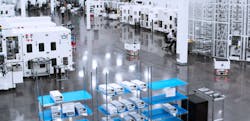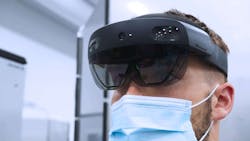No need to worry about baking in the hot Texas sun on a summer visit to Ericsson's 5G smart factory in Lewisville in the Dallas-Fort Worth area: solar panels cover the entire parking lot.
It’s not just a practical manufacturing facility producing 5G radio devices. To hear Carlos Torres, head of Industry 4.0 at the plant tell it, the facility is a proof-of-concept laboratory.
The heavily automated, environmentally friendly 300,000 sq. ft. greenfield plant boasts 120% improved output per employee compared to similar Ericsson plants and uses 100% renewable energy. Rainwater tanks on the roof increase water efficiency. Employees have trained using augmented and virtual reality (AR/VR).
Torres doesn’t think it takes a greenfield plant to innovate, but an exclusive focus on the state-of-the-art sure helps.
“It matters in the sense of we can learn quicker the benefit of the use cases and then share that across all of our sites,” Torres says. “If we were trying to start off from not a greenfield location, it would take longer to achieve that insight. But we have very deliberate, ongoing work to scale out any advancements across any of our factories at a global level.”
Start Smart Factories from the Top
Ericsson invested about $100 million in the plant, announced in June 2019. The first 5G radio device rolled off the lines in March 2020.
Torres repeats his goal for the facility often enough to sound like a mantra: “I want to build transparent, optimized, autonomous and connected systems,” to analyze and diagnose issues to increase efficiency and safety.
“We wouldn’t have made such a significant investment with such ambitions aspirations without a top-down driven approach,” says Torres. “The key here is the ground up is important, too. So, we can have a vision and try things early and often. You can only do that with upper-level support.”
“Places that don’t have this top-down buy-in, you get caught up in the ‘Do a pre-study,‘ and ‘Give me the ROI,’ and ‘What’s the business case?’” Torres adds. “I’m not saying that we ignore profitability. But you have to have a vision for a factory that is pushing the boundaries of these technologies and their coming together and be okay with, ‘We don’t exactly know how we’re going to get there but we trust that our people are going to figure it out and I’m going to support them.’”
IIoT is the Essential Scaffold
For some manufacturers, says Torres, using IIoT infrastructure to gather and analyze data to produce general plant reports may alone satisfy their use of the technology. When an entire team works from a single truth, it’s easier to understand the various steps in a production process.
For an industry 4.0 facility, IIoT needs to go a step further, crunching data to get predictive and prescriptive, to handle all the variances and complexities in a modern manufacturing environment, to drive the evolutions that make production better, faster and safer. The Lewisville plant’s data lake—or central data repository—to that end stores information gathered by a sprawling web of IIoT devices.
“How do I believe I’m going to get to transparent, optimized, autonomous, and connected systems?” asks Torres. “It’s by having everything laying in one place that’s also ready to handle… abstractions of data, and data governance, and data engineering, and ‘How do I get the data there in real time?’ and ‘How do I figure out insights from raw information?’”
The Lewisville plant features a 65% reduction in manual material handling through deployment of automated guided vehicles (AGVs) and autonomous mobile robots (AMRs). AGVs pick up materials from inbound and transport them to storage racks, and transport finished products to outbound. AMRs, coordinated with fleet management software, carry component reels to production cells, and completed products to testing stations.
“5G radios are a pretty advanced piece of technology. The complexity manifests itself in thousands of components of various shapes and sizes that we need to piece together,” says Torres. “So we’ve automated our storage and retrieval [to] ensure that we have the right materials at the right time when we need them in the production processes. This leads to efficiency improvements and reduced downtime.”
Machine learning-based vision systems inspect finished products to identify and diagnose the origin of production errors. Other vision systems provide safety checks for employees by analyzing video and determining the presence of appropriate protective gear.
Data are captured and analyzed from all of these operations, giving Torres and his team deep insight into plant operations and where to make improvements at a granular level.
Smart Factories Are Green Factories
The solar panels in the parking lot are bifacial–capturing direct sunlight on top and reflected sunlight on the bottom. This sea of solar panels captures 17% of the total power used by the facility. Green e-certified wind power provides the other 83% according to Bhushan Joshi, Sustainability and Corporate Responsibility leader at Ericsson and heavily involved in the Lewisville plant since its inception.
Ericsson has committed to reach net zero carbon emissions at all its facilities by 2030. Green energy featured into plans for the Lewisville plant from the get-go, with the need to maximize every opportunity. Finding the correct location for the solar panel grid, for example, presented a challenge.
“We couldn’t install solar on a roof because the roof wasn’t designed to have that much weight,” says Joshi, “which meant that we had to go onto the parking lot to maximize the amount of solar installation we can have on site.”
The plant's energy performance compares against a “baseline site” determined by the U.S. Green Building Council. Joshi says the Lewisville plant runs 24% more efficiently than a baseline plant, assisted by a building management system (BMS) that tweaks HVAC and lighting settings to conserve power.
Two tanks on the roof of the plant may capture up to 40,000 gallons of rainwater to collect and reuse. The plant features water efficient faucets and toilets and the landscaping around the plant uses drought tolerant, native plants. All of these steps allow the Lewisville plant to use 75% less water than a baseline facility.
“They’re standard off the shelf technologies for the most part,” says Joshi. “We’ve stretched the boundary a little bit but obviously we couldn't deploy anything that wasn't available commercially.” Joshi also notes that the green technologies deployed at the plant could incorporate into brownfield facilities, as well.
Maintaining and Training With AR/VR
The Lewisville plant boasts a 10% improvement in maintenance labor compared to similar Ericsson facilities, thanks to the use of augmented reality and remote assistance. Technicians at the Lewisville plant can wear Microsoft Hololens glasses with cameras that share their point of view with remote engineers who can add arrows or work instructions to the technician’s field of view.
“We have a lot of experienced engineers globally. That makes it simpler for us to connect with engineers at other sites that may or may not have experienced [an issue] in the past, which means our insights or troubleshooting is faster,” says Torres.
Engineers in Lewisville use VR to view 360-degree recordings of Ericsson’s smart factory in Tallinn, Estonia. “This is highly useful as we spend a lot of time collaborating on solutions. Understanding the constraints of our sister sites goes a long way in improving our designs to work and scale globally,” says Torres.
Ericsson also, before the plant opened, onboarded Lewisville employees in VR using the same 360-degree recordings of the Tallinn plant.
“The same technologies that we’re using to create advancements in the production processes [can] also shorten the time to competence of our employees in such a complex way,” says Torres. “You’re not in a classroom setting. You can look at something in 3D and visualize it and [virtually] touch it. We just gave people another way to see and learn something beyond PowerPoint or web-based training or whatever technologies from 20 years ago.”
Using 5G to Make 5G
Private 5G wireless networks represent a burgeoning technology in the manufacturing world. This is no different at the Lewisville facility. Torres and his team experimenting with 5G, like preparing to move the plant’s BMS from an internal 4G network to the 5G network.
“We have a 5G network setup at the factory, available to experiment [with] and be able to say why it’s better [than 4G]. So that’s part of the showcase aspect of this factory,” says Torres.
“Every day, I get new pre-study requests which then translate to some form of sensors existing on our production technology lines…. The data that the sensors are producing, it’s requiring a lot more compute,” adds Torres. “I do see a point when we’re going to need the robustness of 5G as a technology to be able to handle all of these advancements.”
Driven By Want, Not Need
In 2020, the World Economic Forum added Ericsson’s Lewisville facility to its list of Global Lighthouse factories, plants that exemplify what industry 4.0 technologies may accomplish, a clear recognition of Ericsson achieving its goals for the plant.
For Torres, building the Lewisville facility isn’t about trying to win accolades. Pursuing industry 4.0 technologies is an absolute necessity.
“We need to do this in order to stay competitive. We need to be pushing the boundaries of technology to keep up with the demands of a more complex world and situation that we’re living in,” says Torres. “If you’re not doing it, then you’re Blockbuster Video, right?”
About the Author
Dennis Scimeca
Technology Editor, IndustryWeek
Dennis Scimeca is a veteran technology journalist with particular experience in vision system technology, machine learning/artificial intelligence, virtual and augmented reality, and interactive entertainment. He has experience writing for consumer, developer, and B2B audiences with bylines in many highly regarded specialist and mainstream outlets.
At IndustryWeek, he covers the continuing expansion of new technologies into the manufacturing world and the competitive advantages gained by learning and employing these new tools.
He also seeks to build connections between manufacturers by sharing the stories of their challenges and successes employing new technologies. If you would like to share your story with IndustryWeek, please contact him at [email protected].



